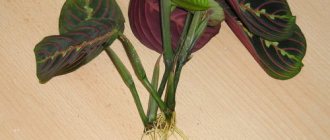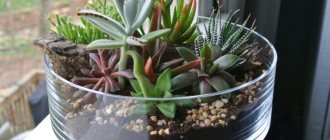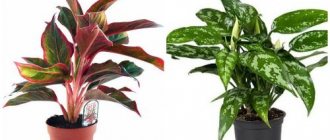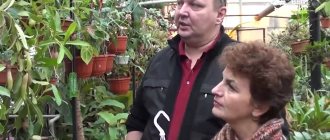Pandanus (Pandanus) or pandan
Pandanus is a tropical evergreen tree plant native to the Indian Islands. This tree is also called the screw palm because it really looks like one. Pandanus has long leaves that grow in a spiral. Usually in its native places the plant bears fruit and flowers, however, at home it does not do this. Some of its fruits are edible, and some are poisonous.
A young plant produces 2 or 3 new leaves per year, older ones grow more intensively. This plant is distinguished by its extreme longevity, even in a home environment.
Pandanus care at home is not complicated and will not be difficult. However, the tree itself grows very quickly, so anyone who does not have the opportunity to provide it with enough space at home should not purchase it.
Important! Some types of pandanus have spines on the edges and bottom of the leaves, which can be quite sharp. However, gardeners say that their cats eat pandanus leaves and nothing happens to them, but in children, an allergic reaction can be caused when cut. Therefore, for those who have children or pets, it is better not to have such a plant.
In the wild, pandanus grow so-called “stilted roots” or “aerial” ones, since they grow not from below, but somewhere from the middle of the tree. Later these roots sink deep into the earth. Thanks to them, a tree that grows tall can be more resilient.
At home, such aerial roots usually do not grow. Although in practice it has been noticed that stilted roots sometimes appear on large flowerpots. In this case, there is no need to trim them! On the contrary, especially during the hot period of the season, it is necessary to strengthen them with sphagnum (a marsh plant from the genus of mosses) and sufficiently moisten them with water. If this is not done, the plant may die. To avoid this, if you have a large tree at home, install special supports so that it can stay firmly on its feet.
Possible problems during cultivation - table
| Problem | Cause | Elimination methods |
| The appearance of a brown tint on the tips of leaves |
|
|
| Yellowing of leaves |
|
|
| Loss of color intensity |
|
|
| Drying leaves | Burn from direct rays of the sun. | It is better to move the palm tree to a semi-shaded place. |
Pandanus species
The variety of pandanus is impressive in its quantity. About 700 species of this tree can be found in nature. Most of them in the wild bear tasty fruits similar to pineapple.
However, despite the many species, only three of them take root at home - these are Pandanus Sandera, Pandanus Useful and Pandanus Veitch. Their variety can be seen in the photo.
Pandanus Sanderi (Pandanus sanderi) . This type of Pandanus is the smallest of its relatives. Its leaves are green in color with yellow patterns on it. Such leaves reach a length of up to 8 centimeters and a width of up to 5 cm. Sandera has sharp thorns on the edges of its leaves.
pandanus sandera
Pandanus useful (Pandanus utilis). This tree is very large, at home it grows up to 3 meters in height, and in nature up to 20. The leaves have a dark green tint and can reach a length of up to 15 centimeters and a width of up to 10. These leaves have a rigid structure and are red spines along the edges of leaves.
useful pandanus
Veitch's pandanus (Pandanus veitchii) . This type of plant is more bush-like, because the tree pillars themselves are not very tall. However, there are cases where it grows up to one and a half meters in height. This species is distinguished by leaves that are twisted in a spiral along the trunk. Also, the color of the leaves is distinguished by its bright green hue.
Veitch's pandanus
Description
A large tree, in nature it can grow up to 15 m, the maximum size is 25 m. When grown indoors, the trunk reaches no more than 1.5 m. The surface is similar to a screw, which is why pandanus is called a screw palm. The root system is separated from the trunk and is considered an excellent anchor for holding the plant in place during strong winds and hurricanes.
The foliage is narrow and elongated, from 10 to 15 cm wide. The leaves are placed on the trunk in several rows, in the shape of a spiral. Flowers are unisexual. Male ones are similar in appearance to spikelets, female ones are cone-shaped. The fruits are dense and red.
Pandanus care at home photo
Transplantation without the risk of injury. Step-by-step instruction
The palm tree needs to be replanted in the spring.
The sequence of transplanting pandanus into a new container is as follows:
- First you need to prepare a spacious, tall container, the bottom of which should be filled with a drainage layer of pebbles to 1/3 of the height of the pot.
- Prepare a new soil mixture to add after moving the plant.
- Then carefully collect the pandanus leaves at the top and secure them in this position with a wide ribbon.
- Considering the significant fragility of the pandanus root system, you need to tilt the old pot, holding the pandanus by the base, carefully remove the plant with a lump of earth and move it to a new container, in which the planting level should not be lower than in the old pot.
- Fill the empty spaces in the pot with new soil, compacting it slightly.
- Untie the foliage of the pandanus, check the stability of the plant and the verticality of its trunk.
An adult pandanus, if it is significant in size, does not need to be replanted if its tub has a suitable volume. In this case, you need to replace the top layer of soil with a new mixture to a depth of up to 1/3 of the height of the tub.
Plant care
As already mentioned, in principle, pandanus is an unpretentious plant. If it feels comfortable, it will not tire its owner. The most important thing for a plant is sufficient space. Since the plant is large, it is necessary to allocate a place for it so that it does not touch the surroundings and does not rest against the wall.
Temperature and lighting
For pandanus, it is very important that the air temperature in the living room does not fall below 18 degrees Celsius. The plant does not like direct sunlight, however, it needs sufficient lighting. If the tree stands in a poorly lit place, the leaves may turn from variegated to dark. In other cases, this threatens the death of the plant.
If the plant does not have enough lighting, then it must be provided with artificial light. Such light should be located at a distance of one meter from the pandanus. When such a flowerpot stands on a windowsill near a window, it needs to be rotated periodically so that the light falls evenly on all the leaves and contributes to the good development of the flowerpot.
If you live in a private house, pandanus should not be taken outside. He does not like drafts, direct radiation from the sun and rain.
Accumulated dust on the leaves must be removed with a cleaning broom or a damp cloth. Dry air harms the plant, the tips of its leaves will wither, however, spraying is also not suitable for it. What to do then?
Since the plant does not like dryness, it is necessary to carefully spray the air around the pandanus with a spray bottle. Or you can plant sphagnum moss on the tray of the pot, which will be regularly moistened.
Watering
Naturally, in spring and summer, the flowerpot needs abundant watering, for example, every other day. For the winter we slightly reduce the amount of water.
Make sure that the soil around the tree does not dry out and that there is no residual water in the tray. If you water the flowerpot through the tray, then after half an hour the water must be drained. The temperature of the water for irrigation should be at room temperature.
Attention! When water gets into the leaf axils and remains there, it harms the plant as it begins to rot.
Soil and fertilizing
Lightly clayey soil, which is very nutritious, is well suited for indoor pandanus. In stores dedicated to flowerpots, you can buy a ready-made mixture for palm trees; it will also please your plant. You can make your own soil. To do this you need to take:
- leaf soil;
- sand;
- turf land;
- humus.
Everything should be equal!
Top dressing
You need to start feeding the flower from March to July; for this, use liquid fertilizers designed for pandanus. This procedure must be done once every two weeks. In winter, you can also fertilize pandanus, but only once a month.
Living conditions depending on the season
| Season | Humidity | Content temperature | Lighting |
| Spring-summer | Pandanus tolerates dry indoor air well, but it is impossible to constantly keep the plant at low humidity; the flower may die. The optimal level should be 60%. This can be achieved by periodically spraying the leaves. | + 20–22 оС | The screw palm requires bright but diffused light. To avoid burns, the pandanus should be placed near the eastern or south-eastern window, curtained with tulle. Some species (with green leaf color) are shade-tolerant. A pot with green-leaved pandanus can also be placed in the back of the room. |
| Autumn-winter | With the onset of the heating season, the plant should be placed away from the radiators and the pot should be placed on a tray with wet expanded clay or pebbles. This technique will help maintain the required level of humidity. | + 18–20 oC. Can withstand short-term temperature drops of up to 12 degrees. | In winter, it is best to place the flower near a window facing South. If the plant is large and it is problematic to place it on the windowsill, then you should provide the pandanus with additional lighting using a phytolamp installed at a distance of 30–40 cm from the crown of the flower. |
Pandanus propagation
The most favorable time for propagation of this beautiful tree is spring. Almost all types of pandanus reproduce by seeds.
Cuttings
However, some domestic species have side shoots (cuttings) that can be cut off. They must have aerial roots and the shoot must be at least 20 centimeters long. Short ones are not suitable because they form roots poorly.
To reproduce you must have:
- suitable container;
- loose soil or peat with sand;
- film.
Having all this at hand, root the cuttings in a container with soil and sand and cover tightly with a diaper. The sprout must be ventilated periodically, but hot temperature plays a significant role. Is she suitable for reproduction at 28-30? Celsius. After about one and a half to two months, the roots will take root.
Seeds
However, if you have Pandanus Beneficial, then it reproduces using seeds. To do this, you need to have river sand and peat where the seeds are sown. After sowing, you need to water the soil a little and cover it with an impermeable film.
Once a day it is necessary to ventilate such a mini-greenhouse. Seeds must be watered regularly. At the required temperature, namely at least 25? above zero Celsius, the sprout will appear in about 3 weeks. When several leaves appear, they can be transplanted into the pot you need.
Rosettes
The mother bush has rosettes for propagation. They need to be cut off when they are at least 20 centimeters long. In order to root them you need:
- dry the roots;
- 2 centimeters of drainage;
- 7 centimeters of turf;
- 4 centimeters of sand;
- 2 centimeters of coarse sand;
- plant the rosettes 2 centimeters deep.
Sockets need to be well compacted into the ground and sprayed regularly. In the same way as with any propagation of pandanus, complete isolation in a diaper cover and regular ventilation are necessary. Phytohormones are great for accelerating the germination of rosettes. After about two months, you can transplant the cuttings into a suitable pot.
Attention! If someone does not have experience in propagating pandanus, then it is worth watching a video on how to do it correctly.
Plant propagation instructions
Pandanus can be propagated by cuttings or by dividing the bush into several parts.
To propagate by cuttings, you must do the following:
- Carefully separate side shoots up to 20 cm long from the trunk.
- Areas damaged after cutting should be sprinkled with charcoal powder.
- Prepare and pour into a container a mixture of peat and sand in equal proportions.
- Place the prepared cuttings in pots, then cover with a glass cap or film.
- Remove the seedlings to a warm, bright place and grow at a temperature of 25 - 28ºС, periodically watering the soil with a spray bottle and ventilating the plants.
- Complete rooting occurs 6–8 weeks after planting.
To propagate pandanus by dividing the bush, you must follow the following instructions:
- When new rosettes with a length of 20 cm or more are formed near the main trunk and have taken root, they must be carefully separated from the bush.
- Leave the separated plant for a day to dry.
- After this, take a shallow container, lay a layer of drainage (15-20 mm) on the bottom, then add turf (60-70 mm) on top, then washed sand (30-40 mm).
- Lightly bury the new shoot to a depth of 20 mm, surrounding it with a small layer of wet moss, which must be moistened periodically. The temperature of the prepared soil should not be less than 22 °C for comfortable rooting of the rosette.
- Cover the planted rosette with a glass cap or a transparent bag, then put the container in a warm, bright place.
- The process of forming a full-fledged root system takes 4–6 weeks.
- After 2 months, you need to prepare a mixture in a new pot consisting of 3 parts leaf soil, 2 parts turf and 1 part sand.
- Move the rooted shoot with root soil to a new pot for further growth.
Pandanus transplant
If you have a young tree, then it needs to be replanted once a year, since it grows intensively. If the tree is more mature, then once every 2-3 years. Replanting the plant must be done very carefully, since, as already mentioned, the tree has aerial roots that cannot be damaged.
The most favorable type of replanting is to transfer the tree from one pot to another, without even shaking off the soil from the roots. The new pot for the plant should be larger in size than the previous one, and it is best to cover the bottom with drainage.
It is necessary to plant pandanus roots at the same level as they were before, since the empty bottom will give it the opportunity to take new roots and grow.
However, if you have a young tree, you should not replant it in a pot that is too large for it. The roots will not be able to assimilate, which will lead to their rot and death of the plant.
Potted plants that decorate gardens or terraces do not need annual replanting; the only thing that is necessary is to add soil.
If you have a pandanus species that has sharp thorns on the edges of the leaves, then when replanting, wear gloves and gather the leaves into a bunch.
When the owners do not have enough space for such a large flowerpot, they can replant it a little less often - this will reduce the growth of the tree.
Important! If the plot of land is completely covered by pandanus roots, this is an urgent signal to replant the plant.
Signs
Is it possible to keep pandanus at home?
Despite the well-deserved popularity of pandanus, sometimes readers of our site ask whether it is possible to keep it in an apartment. Rumor has it that it absorbs positive emotions and transforms them into aggressive energy, which negatively affects unbalanced people, making them angry and overactive. What's the answer here? If you are impressionable and have a hard time withstanding troubles, you may experience discomfort near the pandanus. In this case, it is better for you not to keep the plant either at home or at work. And for people with a strong nervous system, novice gardeners and those who often go on business trips, pandanus is an ideal plant: it is beautiful, unpretentious, does not require frequent watering and grows quickly.
Diseases and pests
Most often, such a plant faces problems such as:
- Scale insects.
- Spider mites.
- Mealybugs.
- Dry or yellow leaves.
- Fungal infections.
Typically, pandanus is a very resistant plant to various diseases and is quite “tenacious”. Still, there may be difficulties that will cause trouble for the owners of the tree.
Scale insects are insects from the scale insect family. Their variety is amazing in its number, since there are about 2400 species. When they infect a tree, round or oblong immobile individuals are found on it.
Since their variety is very wide, they can be completely different in size and color. For example, they may differ in color: yellow, orange, brown, cherry, etc.
There is a type of scale insect called the palm scale insect, so the pandanus will be most affected by this insect. Typically, females of such scale insects are transparent or pale light. They have a round or flat shape with a diameter of 2 mm. And males are pale yellow and have a fluffy larva of a more linear shape, white. During an attack by scale insects, massive damage and drying out of leaves is observed.
There are also similar parasites, which is why they are called “false scale insects”. The insect is covered on top with a shield, which differs in shape from ordinary scale insects. In the false scale insect it is pea-shaped. They are often brown, yellow, red or green.
They also suck the juice from the leaves, which then forms a yellow spot that grows over time. Because of this, the leaves dry out and expose the tree. To get rid of such pests, you need to repeatedly wash the plant with soap and water or diluted alcohol.
Spider mites are a family of mites that attack houseplants. They are very small in size, about 1 mm in length and have a round shape, and are usually red, yellow or brown in color.
When plants are damaged, they release webs. After this, traces remain on the leaves, as if merging with a drop. As a rule, ticks are found on the lower parts of leaves, as if hiding from people.
For such insects, the most favorable environment is high air humidity. During damage, the leaves become covered with light spots and cobwebs. This happens because the larvae bite through the leaves and draw out the juice from them, which is why they dry out.
Controlling these pests can be difficult and time-consuming. Since laid eggs can remain alive for up to 5 years and hide under the bark, on the window frame, in the cracks of the window sill, on the pot. Acaricides help treat this trap.
Mealybugs are a family of semi-Coleoptera of the suborder Coccidae. There are over 2,000 species of these scale insects. Sometimes these insects are called “hair lice” because of their appearance.
Such pests can be noticed faster than those mentioned above, since they have a length of 5-6 mm, and sometimes as much as 10. They usually have a white powdery color. When infecting a plant, scale insects secrete a waxy, whitish, vape-like secretion.
They suck out all the juices from the leaves and shoots, and sometimes they also affect the root system, so the growth of the plant is greatly slowed down. Such pests love dry conditions, so they will not like a humid environment and frequent air spraying.
To finally overcome mealybugs, you can take a cotton swab, moisten it with water and soap it a little, remove everything unnecessary from the pandanus.
Pandanus diseases are not associated with parasites
- The leaves dry out, and their tips turn brown - this means that the plant does not have enough moisture in the air and in the roots. It may be due to lack of nutrients. If you slightly cut off the brown dried tip, while leaving a millimeter strip to the green leaf, then there is a chance that the plant, after watering, will return to its previous appearance.
- If the leaves turn yellow, this may indicate too much humidity and possibly rotten roots. In this case, you need to carefully remove the roots and, if there are rotten or lifeless ones, cut them off. Next, plant the flowerpot back and avoid making the same mistake.
- If the leaves of the pandanus are pale and dull in color, this indicates an excess of lighting, hard water for irrigation or an excess of calcium in the soil. When you observe that the leaves do not grow to a certain size, the reason for this may be a lack of light or feeding.
- When dry spots appear on the leaves, these are burns from direct rays of the sun. Therefore, by finding the cause of your plant’s illness, you can help it regain its former beautiful appearance!
However, the pandanus plant itself is not capricious! If the humidity, lighting and watering suit it, then it will please your eyes without problems and for a long time!
PS I often hear from colleagues and acquaintances about their desire to master the English language. In our modern world, such a wish can easily come true. You just need the Internet for this. Together with your friends, acquaintances and children, you can learn English online in a short and convenient time. Classes are conducted in various options: Skype, tutor or online media, both for beginners and for those who already have skills
Mr. Summer Resident warns: Pandanus is an energy vampire
Today, pandanus can often be seen in offices and apartments, but before it was not particularly loved, because the flower is considered an energy vampire and is believed to be able to draw out positive emotions from the owners of the house. Because of this, impressionable people who do not tolerate stressful situations well may feel a certain discomfort and even depression around him.
In addition, it is not recommended to bring the plant into the bedroom or living room due to its spiral shape. These trees have a strong character, and their energy spreads throughout the room in a spiral, filling it with heavy energy.
Due to the thorns at the tips of pandanus foliage, the energy emanating from it is believed to be prickly and unpleasant. This makes it difficult to be indoors; the flower puts pressure on the psyche. For people with a caustic character, it is contraindicated, since it will aggravate an already specific attitude towards others.
But there are certain benefits from this plant. If a person has too soft a character, it will teach you how to behave correctly with enemies and be able to defend your own position.
As a garden decoration, pandanus is simply irreplaceable, since it can green a large area. It is better not to place it near other representatives of the flora.
Why do the leaves turn yellow?
Pandanus is a very hardy plant. It is practically not damaged by diseases and pests. In exceptional cases, scale insects and false scale insects may appear on it, which can be removed with the help of Actellik. Treatments are repeated at intervals of 3 days, 2-4 sprayings are sufficient. Single pests are removed from the leaf with cotton wool soaked in vodka.
If the air is too dry, the tips of the leaves may dry out and turn brown. Despite its tropical origin, the palm tree does not need high air humidity, but in winter, when central heating is on, it will appreciate daily spraying - this will help protect the tips of the leaves from drying out.
The leaves turn yellow due to lack of nutrition. Like any fast-growing plant, pandanus needs high doses of fertilizer. Regular fertilizing in spring and summer and keeping the soil moderately moist will keep the leaves green and healthy throughout the year.
We suggest you find out how long it takes for petunia to bloom
Variegated varieties lose their brightness, and new leaves grow small? This happens due to lack of light. In winter, it is better to move the plant to a south window. Due to excess light, the leaves become whitish. Also, the leaves may turn white due to watering with hard water with a high calcium content. Pandanus can easily be called the king of the winter garden.
This is a great tapeworm. In the open air, the plant is transformed and looks luxurious and majestic. The screw palm never bends towards sunlight, even if the lighting is insufficient. It will always be slender and straight, only the foliage on the sunny side will be denser. The plant is kept in the room until about ten years of age, and then it is better to find more suitable conditions for it.
So, caring for pandanus is not difficult. The plants are unpretentious, hardy, and survive in darkened halls and vestibules, away from windows, in drafts. It is worth getting a pandanus if you need a fast-growing, unpretentious indoor flower that looks like a dracaena, yucca or palm tree.
Pandanus is very easy to care for, but if you neglect the recommendations described above, the plant may get sick or be attacked by pests. Let's consider a list of possible problems when growing a flower.
- Red spider mite, scale insect. Insects appear when there is insufficient watering, lack of ventilation and low air humidity. Pests should be removed using a cotton swab soaked in alcohol. To completely kill insects, the screw palm is irrigated with a solution of anti-insect preparations.
Red spider mites and scale insects - Mealybug. Appears in waterlogged soil. The pest leaves a sticky white coating on the leaves, which gradually acquires a brown tint. For treatment, pandanus is irrigated with a solution of Karbofos or Actellik.
- Drying leaf tips. The problem appears when there is insufficient watering or weak feeding of the plant with fertilizers. For treatment, you need to increase the humidity level in the room, spray the palm tree with water more often and apply fertilizing in a timely manner.
- Slow growth, lightening of leaves. In conditions of insufficient sunlight, pandanus grows poorly, and excessive lighting leads to a change in leaf color to a lighter color. Depending on the reason, the plant needs to be moved closer to the light source or further from it.
- Yellowing of leaves. The cause may be too much light or too hard water for irrigation. If the leaves of a pandanus turn yellow, then first of all you need to move it further from the light source. In the second case, you need to make adjustments to the watering regime and use only settled water.
Pandanus looks beautiful and exotic in any interior. The flower does not require specific care or special microclimate conditions, so even a novice gardener can cope with its cultivation.
Caring for a pandanus is not difficult, but it is important to constantly monitor its health. The most common problems are that the foliage may suddenly begin to turn yellow and dry out. There may be several reasons for this development of events. Among them:
- diseases;
- pest invasion.
Diseases
The indoor screw palm is a fairly resilient plant. She has good immunity. However, even this exotic plant can contract a disease, such as root rot. When the roots decompose, the above-ground part suffers. It dries, turns yellow, fades. Root rot is a fungus. It occurs due to waterlogging of the soil. Treatment involves transplanting into a new pot and switching to a normal watering pattern (once every 5-7 days).
Several more reasons for yellowing and drying out of foliage:
- keeping the tub in bright light;
- excess calcium in the soil;
- nutritional deficiencies;
- drying out of the soil.
Among the parasites that love pandanus are the following:
- scale insects;
- mealybugs;
- ticks.
It is because of these insects that yellow spots appear on the foliage, or the leaves turn yellow completely and may dry out. If there are mealybugs, then a whitish coating is also visible on the trunk.
Pest infestations don't just happen. Even if the owner carefully cares for the specimen, parasites may still appear. The main reason for this is too dry air in the house.
Drugs used to combat:
- Akarin;
- Fitoverm;
- Apollo;
- Omite;
- Antiklesch et al.
Foliage suffers from pests
Among the folk methods of getting rid of parasites is treating the plant with an aqueous solution of laundry soap.
What to do after purchasing a plant?
When transporting a plant from the store to home, you need to make sure that it is well wrapped and protected from drafts. In winter, the packaging should be closed at the top.
When planting, it is better to give preference to a pot made of natural material with one or more drainage holes. Its porous material promotes the evaporation of excess moisture, as well as the leaching of harmful salts from the soil. 1-2 cm of expanded clay at the bottom of the pot . Use a universal primer.
Remember that the plant is going through an acclimatization period in the first few weeks, so during this time you should keep it in one place, protect it from direct sunlight, drafts, too high and low temperatures, and water it no earlier than the top layer of soil has dried out.











